At 7 AM on Sunday, June 9th, I set out on what would prove to be the prophetically-named Light at the End of the Tunnel Marathon. By the end of the day, I would be a Boston Marathon qualifier and a heart attack survivor.
The weather was perfect. The race began in Hyak, WA, an hour west of Seattle in the Cascade Mountains. After looping around the parking lot, the course entered the dark 2.3-mile Snoqualmie train tunnel and then flowed down a packed stone rail-trail carved into the mountainside, ending in the town of North Bend. The tunnel is the 2nd longest in the country and devoid of any light. Route 90 could be heard faintly in the valley below.

The journey to this race began six years earlier, running for my niece Brianna as a charity runner in Boston. That run that ended 1000m short after tragedy unfolded at the finish line. I finished that race in 2014.
The goal for this June morning was to achieve a 3:35 time to qualify outright for Boston. It would require an average 8:12/mile pace — or 45 minutes faster than I ran in my return to Boston in 2014. I exited the tunnel having run 8:25/mi — a pace on track for only a 3:42. The 3:40 pace group was moving out of view in the distance.
The slow pace through the dark (and flat) tunnel was in my written race plan. Now I needed to follow the plan to gain back 2 seconds a mile in the gradual downhill that remained to hit the Boston Qualifier time (BQ).
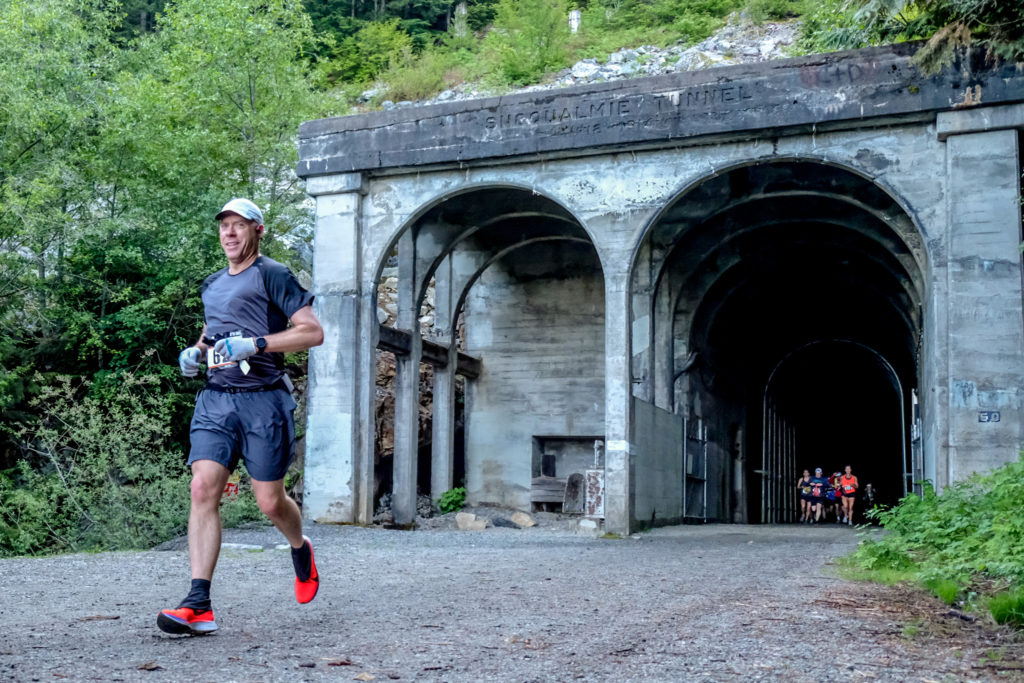
I plodded down the trail and moved to just a second behind BQ pace as I hit mile 23. My first marathon in 2013 had stopped at mile 25.8 after the bombs went off at the finish line. Boston 2014 had ended in a dehydrated, decidedly not “Boston Strong” walk/jog. My last marathon had proceded through torrential rains and finished with high winds and threatening lightning. The final moments of this race would not be less eventful.
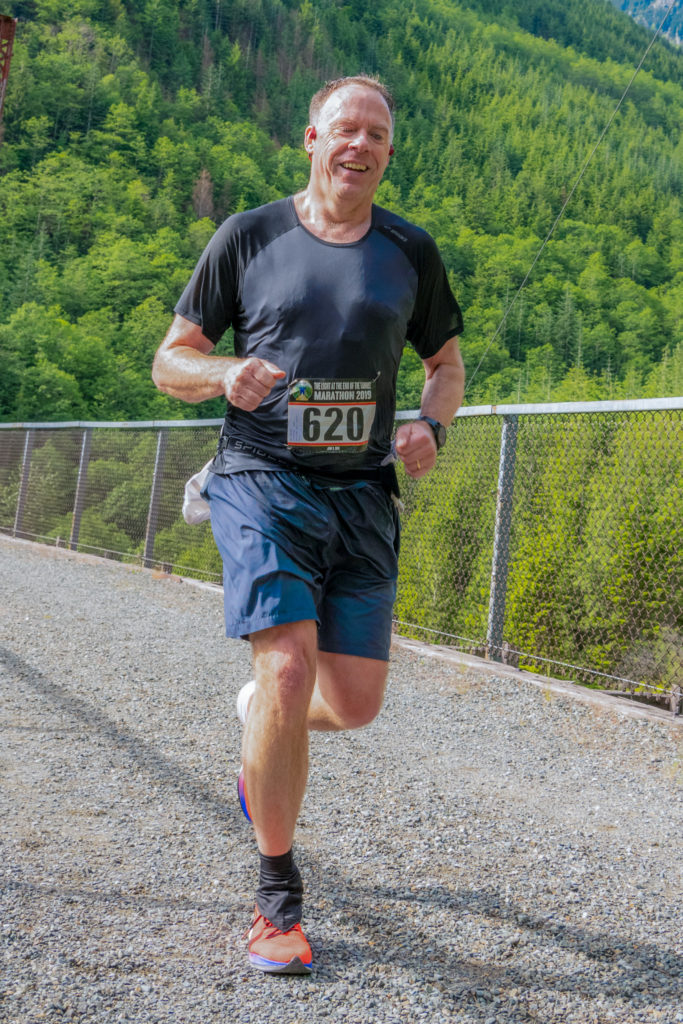
In stark contrast to big city marathons, this course is isolated and inaccessible for all but road crossings at mile 13 and 21. It was just the other runners, the water stop volunteers, and one uninvited spectator — I glanced up after a pace check to the surreal sight of a black bear lumbering onto the trail. This Colorado Trail Marathon photo below captures a similar moment, although my path was narrower and bear bulkier. It didn’t occur to me to break stride — I was a second off BQ pace and dialed in. The bear exited into the bushes as I passed. It wouldn’t be until midnight that I would recall the encounter.

With under a mile to go, I was feeling confident. I sprinted for the finish, reaching the line with the race clock showing just a 3 seconds margin to the BQ 3:35:00.
My official “chip” time was 3:34:44 — 16 seconds (0.7s/mile) ahead of the BQ, and over 18 minutes fast than my September run on the same course. See my Strava entry.
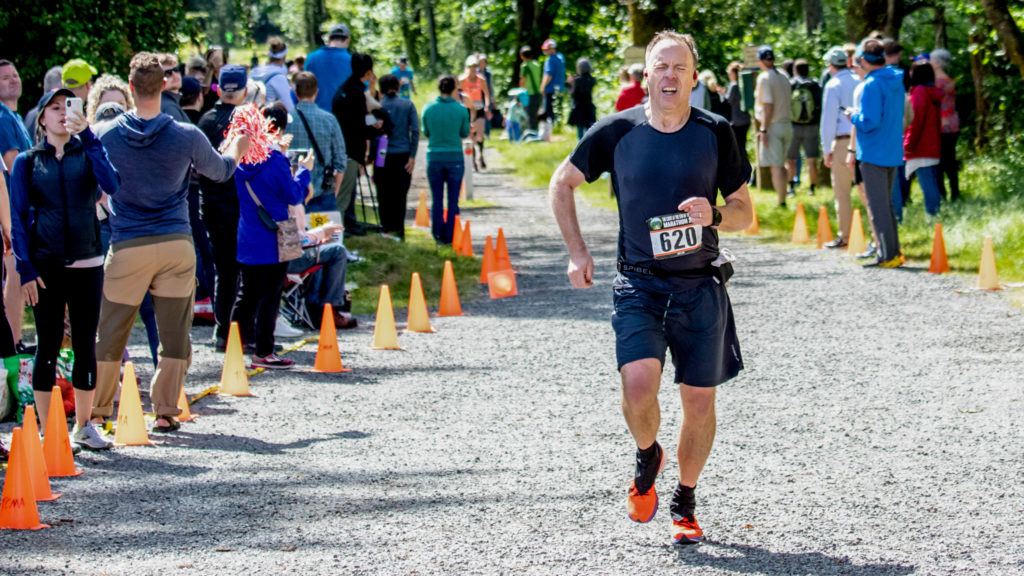
Hitting this beyond-bucket-list goal was emotional. The final miles of a marathon often are tough, and I feared I would come up short for lack of reaching deep enough. But 7000 miles of training since 2012, and a year of professional coaching from Mike Morgan at Luke Humphrey Running had me in the best shape of my life since college, and the race was effortless. Thank you, Mike! Also grateful to the folks at Marathon Physical Therapy for keeping me healthy. Thank you, Erin and Rachel.
But something was very odd.
My legs felt great, but after crossing the line I immediately sat down in a chair next to the finish with excruciating chest pain. In subconscious denial, I referred to it as torso discomfort. I also lacked any appetite for the chocolate chip cookies and bananas that were plentiful in the recovery area. After the race, I would look at the photo and video above and wonder how the pleasant run through 25 miles had turned into that struggling gate and grimace.
I immediately assumed I had consumed too many energy gels without water in the final miles to avoid “hitting the wall”, and this was causing indigestion/heartburn. I dashed off some garbled celebratory texts, skipped the snacks, snapped this photo, and headed back to Seattle.
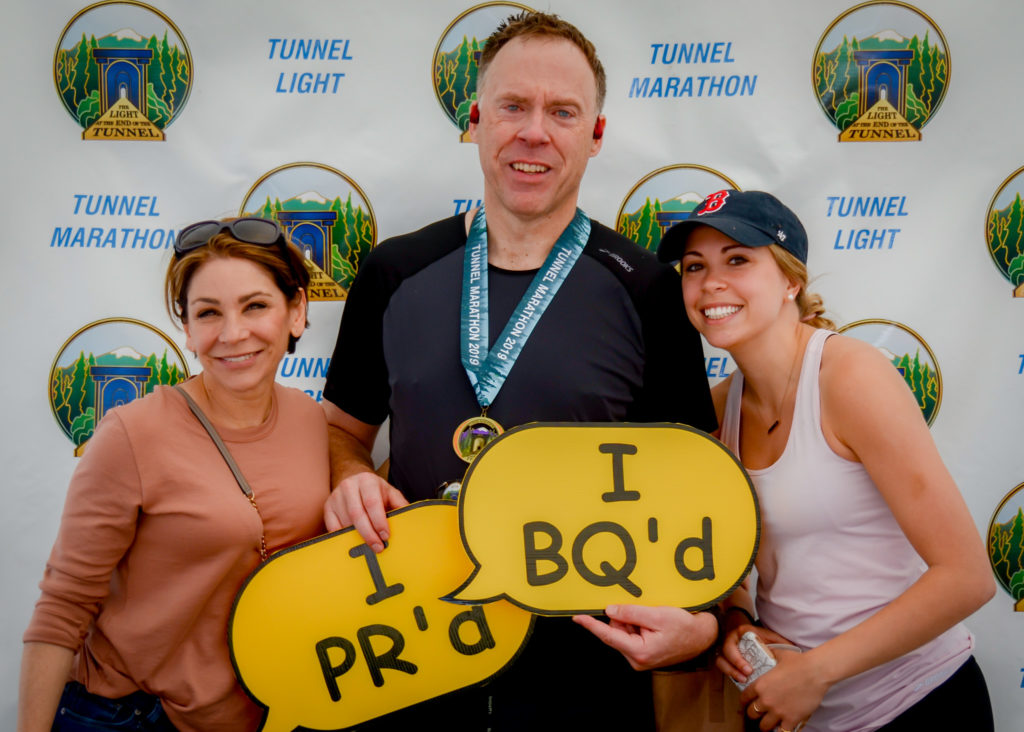
My family headed out on marathon-inspired runs while I showered and headed to bed. When my torso discomfort continued unabated, I decided to make a run to the drug store for TUMS. [Public service note: if you find yourself reaching for TUMS for the 1st time in your life without good reason, you should think again and consider 911/urgent medical care.]. It seemed to help a bit, but not nearly enough. Having done five marathons and many hard workouts, deep down, I knew this wasn’t normal.
I sent two email messages on the race that afternoon that in retrospect are telling: “Was pleasant until mile 25. Legs feel fine. Upper torso is in generalized pain. Maybe indigestion.“… “Excruciating heartburn or indigestion is my main post-race issue. Hopefully, TUMS will mitigate.“
After a few hours, I got out of bed, and we went shopping and to a steak restaurant. My appetite was absent, but I got a few bites down. I slept poorly overnight, but by the next morning, I was feeling better and able to eat breakfast. We flew back to Boston.
The next four days were uneventful. I rested my legs and researched marathon indigestion and alternative gels. All seemed fine until I climbed our front stairs on Friday morning.

A lighter version of the pain I had experienced five days earlier returned, but this time in my upper chest, and with no food to blame. Being a scientist, I reproduced it with a brisk jog up the driveway. I figured it would be prudent to get it checked out before returning to running that weekend.
After some phone tag, my doctor’s office had me come in. An atypical EKG had me driving over to the local hospital (at Boston mile 16) for evaluation. I had a quick peek at the EKG print-out in the waiting room:

Google translated “infarct” for me. My bucket-list BQ had ended in a potentially bucket-kicking myocardial infarction (MI) — a heart attack. Time is muscle in the heart-attack business, and leaving this untreated for five active days was sure to have caused significant irreversible damage. In a heartbeat, I went from my first week of feeling like a “real” marathoner to someone that likely would not run again.
[Side Note — I am sharing this story because I want folks to realize that heart disease is not a hypothetical thing just for unhealthy people, and to convey the tremendous importance of not ignoring unusual medical symptoms. A heart attack is very hard to differentiate from heartburn. I say that now even having experienced both. An EKG can quickly break the tie. ]
My car stayed in the hospital parking garage as I got a $6K ambulance ride downtown to the Brigham and Women’s Hospital Cath lab with sirens blaring.
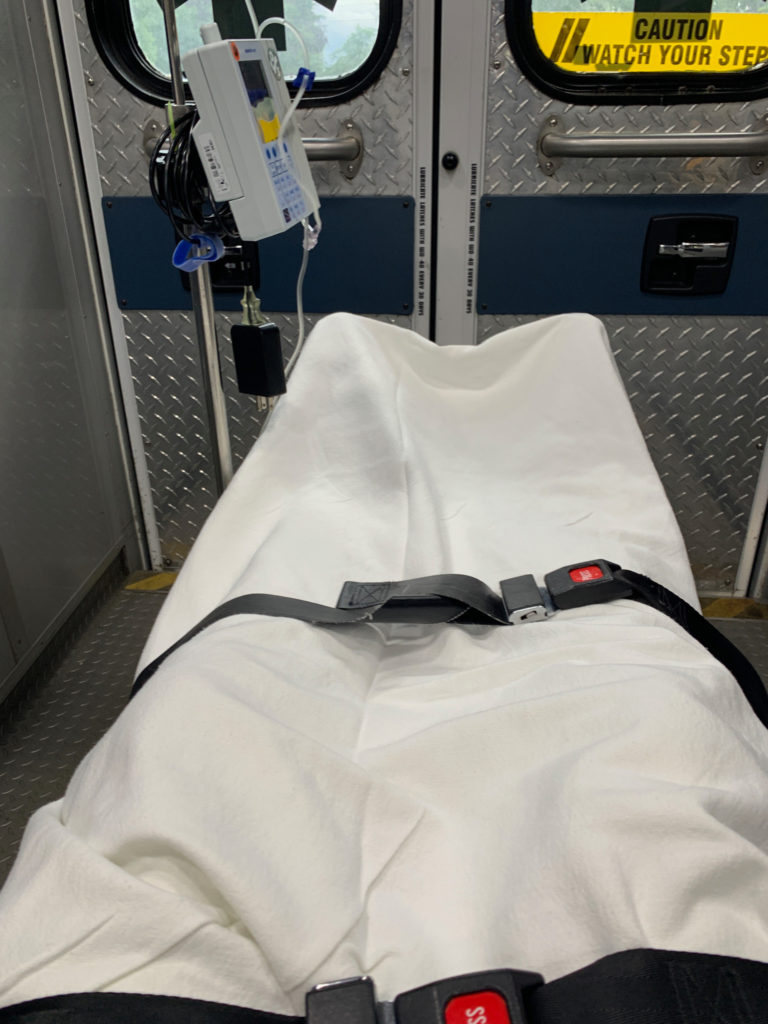
The 1st step in the treatment of a clogged artery is an angiogram. A microscopic tube travels up through the wrist and injects x-ray dye into the chambers of the heart to assess the state of your arteries. My right coronary artery should have looked like the video below:
Instead, this is what the interventional cardiologist found as I lay on the x-ray table that Friday evening:
A cholesterol plaque in the artery had ruptured. Platelets, seeing it as a wound, had 100% clogged it. No blood was flowing to guide my doctor to find the entrance to clear it. Does she opt for open-heart surgery or leave it blocked? How could this have happened to a healthy marathon runner? And how had could I have still been walking around the past five days?
For the answers, continue reading: “Thanksgiving“
Spoiler Alert — the story does have a happy ending, and I’ll be running the 125th Boston Marathon for the Newton Rotary to raise scholarship funds for Newton Rotary. This blog will share the journey to the starting line. Subscribe to follow along.


Omg Jack ! I’m sorry you went through all that. I have enjoyed all your stories and photos over the years. I’ve done 4 half
Marathons but never a full.
God bless and keep running !
Thanks Mary Ann — As you’ll see in part 2, I have nothing to complain about. I feel quite blessed.
I appreciate that you attempted to recreate the symptoms by running your driveway; I thought that’d be the part of the story where you would go down. Glad you are ok!
Holy shit…
So glad to hear you are OK, Jack. Thanks for sharing. It can really save someone else’s life.
I’ve heard to remember that feeling because, if there is a next one, it will probably feel like that. I shared that advice with one of our people and it may have saved her husband’s life.
Heart attacks and cancer are my worst nightmares.
Your fitness level may have saved your life.
Some who exercise extensively are angry in this situation. Hey, I’m doing all the right things and it happened to me!? When they realize that is what may have saved their life, it softens the attitude.
Thanks James — wait til you read part 2… fitness is a big part of why I came out fine.
I worked on a cardiac interventional unit for 3 years and know all too well about heart attacks and cardiac caths. I am stunned it happened to you, but am happy you’re (literally) up and running!
Wow. Your story needs to be everywhere. Many thanks…and congratulations.
Wow Jack, I kept thinking they didn’t place the Angio cath correctly. Shocking. I look forward to part 2. Scott
Hello Jack,
So delighted about the ‘happy ending’. Best to you and family.
Happy Thanksgiving,
Gloria
Thanks Gloria
What strikes me is that you made it all the way home. Your endurance is amazing. The happily ever after is even more heart-warming.
Jack,
One more thing for which we can be thankful – you lived to tell the tale! I like happy endings.
Marguerite
This is great, looking forward to part two!
xo Paula
Glad to hear you’re ok Jack. Lesson heard!
I’m impressed you’re making these marathons strong!
Mark
Thanks, Mark — Thanks for reaching out. One unexpected upside to going public with my story is connecting with so many old friends. Great to hear from you. — Jack
Jack, I am glad to hear that you are ok. Times are changing and we have to realize limitations of our aging bodies. Good luck to you, Abe
Jack – really great to hear it all turned out well. Look forward to reading part 2.
It’s up: https:/boston.jackprior.org/thanksgiving